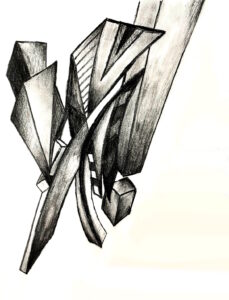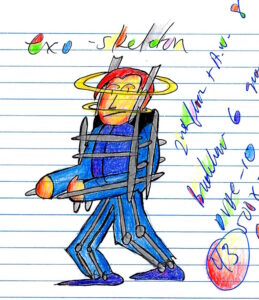The Exoskeleton
Mindful of one of my favorite saws probably picked up from The Internet, “There are two kinds of people: those who place people in categories, and those who don’t,” I nevertheless postulate that there may be three kinds of artist interaction with the world. Let’s assume a high level of talent and hard work/discipline on the part of the artist for all three categories:
Category 1. Good Fortune!
 Those artists for whom something came together, either for enough influence to make a real living, or to at least have an audience, live the “art life,” and see some monetary return. The talent and dedication may be highest here, but luck and who-you-know play a part; any of us can cite numerous examples of trash art that enriched their creators.
Those artists for whom something came together, either for enough influence to make a real living, or to at least have an audience, live the “art life,” and see some monetary return. The talent and dedication may be highest here, but luck and who-you-know play a part; any of us can cite numerous examples of trash art that enriched their creators.
These artists surely have experienced the down moods of the next two categories, but their success must have seemed fated, that somehow “This was how it was all supposed to happen.”
Oooh, and there’s the subset that this early fame destroys. I certainly have no idea how that works.
But as an example of where I’m coming from on this:
I arrive in Houston for my junior year at Rice having previously refused a claustrophobic college (dorm) assignment. I realize I must hunt for an apartment, but being utterly callow I have no idea how to get started. But a friend knows a friend who knows the perfect place: I do nothing but show up and meet the landlady. And so I loved that quirky garage apartment with its extreme privacy and it was the perfect place for art for the next two years. The wonderful thing just landed in my lap, but I had no idea how such good fortune came about, and I certainly never developed apartment-hunting skills. It was just damn good luck, and did seem “fated” to happen–though this story illustrates the value of maximizing your contacts, through which luck flows.
Category 2. Despair
These artists can never seem to get any traction and just give up. Other life events soon dominate everything. The world-ocean slowly covers their sand castles. Nothing is left.
Category 3. Perseverance
These artists keep going no matter what. I know many of them. Which leads me to discuss my exoskeleton.
To support my art, in 1981 I developed what I called a “world structure” around a library career. It became a complex, evolving exoskeleton which sustained my art life well. Despite a few times when I probably admired the exoskeleton a little too much, and veered a bit off course, I stayed faithful with my art. Some accomplishments since 1981:
- 232 paintings
- 12 solo art shows, plus participation in 43 group shows–and some paintings sold
- 17 novels, 13 of these published; 3 novellas, 1 published; 4 other books published
- 238 blog posts
- 2.2 million words in journals
All that is solid work and can be built on. But the exoskeleton worked so well that the true inner skeleton for supporting an art life atrophied. I have had art, but an important sustaining force has been missing. Which is why, when I retired in January 2023 and took a look back at decades of a library world structure, I was surprised by a feeling of rootlessness.
I’ve often maintained that the deleterious effects of my library world structure were simply the waste of time and energy that could have been spent on art and writing. But now I see another issue: the type of energy demanded. Keeping up with the endless problem-solving and decision-making, ranging from trivial daily concerns to the momentous issues that either bolster or threaten your career, as well as the unceasing interaction with people, their expectations, ambitions, and conflicts. You can say all that is unavoidable in human life, but in a structure that’s not your real love, that’s just intended to provide support, it distracts you and diminishes your energies. You find it difficult to replenish yourself, and then discover that you need to spend much time working on the exoskeleton itself to make sure it can carry you through the days.
It’s the nature of the enterprise to snag as much of your attention as it can. It’s hard to do an eight-hour workday without falling into “the corporation’s” psychic needs. And trying to slack off during those eight hours, in the name of “conserving art energy,” actually requires more energy than simply getting the various tasks done as best you know how.
I’m still not sure whether I should’ve remained at some “proper level” to minimize the amount of energy the structure required. For instance, whether to seek to rise, to supervise, to take on more responsibility, and the concomitant question of how much money you need at whatever level you stop at, to maintain housing, food, transportation, and health, and to keep the art life going. Trade-offs in all directions. It was always a struggle, but I did keep coming up for air, painted and wrote.
The exoskeleton strikes me as being like the Hindu/Buddhist idea of the illusory ego self. It kept me going, but at such a cost. It protected the art part but actually weakened it in some ways. Consider an astronaut who’s been in space for a year, but despite all his exercise in orbit, when he finds himself back on Earth he’s unable to walk.
I’m not saying this ruefully; what happened, happened, and I’ve learned from it. And there’s always fuel for art here.
The good news is that in the absence of schedules and deadlines and projects and team-building and looking out for “the career,” I’m finally looking to the endoskeleton. Some accomplishments since retirement in January:
- Novels: Published Asylum and Mirage and began Supreme Commander Laurie
- Published 13 blog posts
- Conducted 3 interviews with VoyageDallas
- Created a fun trailer for my novel Collapse and Delusion
- Began fresh experiments in two art journals
- Error-corrected all seven Jack Commer novels and republished these
- Digitized hundreds of pages of important older writing (stories, the Wiess Crack, letters, journals). Yes, some looking backward has been in order.
This initial period is taking longer than I’d thought it would, but I can feel it drawing to a close. I realize I’ve been putting off thinking about some of the creative plans I wrote up as I came up to retirement. I need to assess whether I’ve really needed to rest before going after them, or whether I really want to do them at all. In which case they could be standing for something else much better.
copyright 2023 by Michael D. Smith
Footnote 1: I’m glad I’ve kept this account: https://sortmind.com/art/shows-and-exhibits/
Footnote 2: As for the journal count: For handwritten journals not yet digitized, estimate words per page and multiply by number of sheets stated on the cover of the notebook. Then multiply by 2 because of course you write on both sides of the sheets. All others use Word’s word counts. I know this sounds obsessive but I want to keep track of how much is left to digitize.


Pingback:A Writing Biography, Part V: Space, Time, and Tania through The University of Mars, 1974-1982 – Sortmind Blog – Michael D. Smith
Pingback:Supreme Commander Laurie – Manuscript Status and Spaceships – Sortmind Blog – Michael D. Smith
Pingback:A Writing Biography, Part VI: Failures, Successes, Rhythms and Swerves, 1983-1994 – Sortmind Blog – Michael D. Smith
Pingback:A Writing Biography, Part VIII: The Exoskeleton, Archiving, Publishing, The Blog, and the Long Novels, 2011-2023 – Sortmind Blog – Michael D. Smith